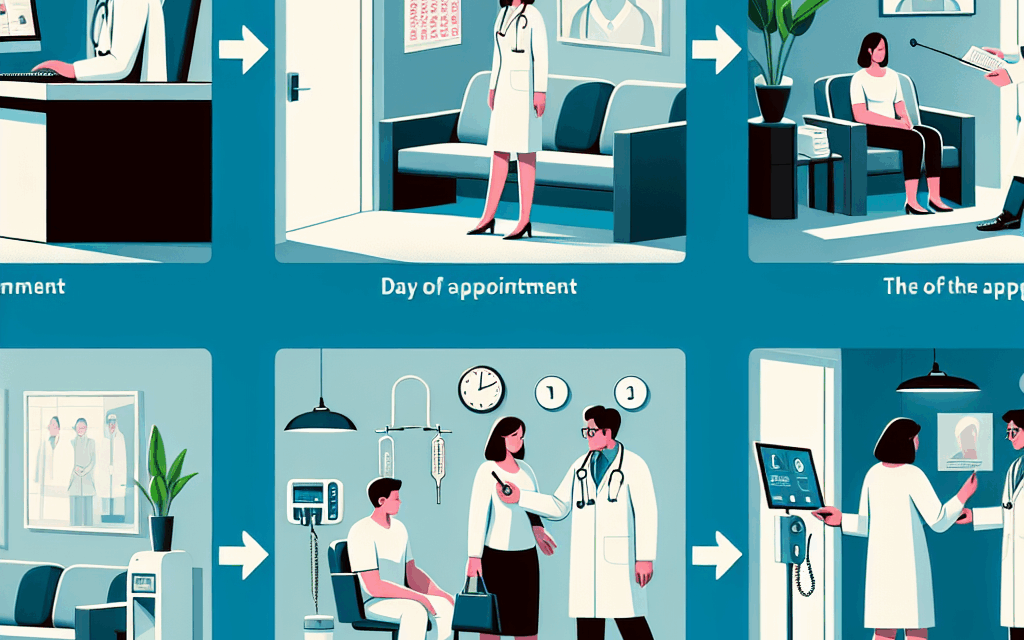The Complete Journey of a Medical Appointment: From Scheduling to Follow-Up
In today’s fast-paced world, healthcare has become an essential aspect of our lives. The journey of a medical appointment is often complex, involving multiple steps that can significantly impact patient outcomes. Understanding this journey—from scheduling an appointment to the follow-up process—can empower patients and improve their overall healthcare experience. This article will explore the complete journey of a medical appointment, breaking it down into five key subtopics: Scheduling the Appointment, Preparing for the Appointment, The Appointment Itself, Post-Appointment Care, and Follow-Up Procedures.
1. Scheduling the Appointment
Scheduling a medical appointment is often the first step in the healthcare journey. This process can vary significantly depending on the healthcare provider, the type of appointment, and the patient’s needs. Here, we will explore the various methods of scheduling, the importance of timely appointments, and the challenges patients may face.
Methods of Scheduling
Patients can schedule appointments through various methods, including:
- Phone Calls: Traditionally, patients would call the healthcare provider’s office to schedule an appointment. This method allows for direct communication but can be time-consuming, especially during peak hours.
- Online Portals: Many healthcare providers now offer online scheduling through patient portals. This method is convenient, allowing patients to book appointments at their convenience without waiting on hold.
- Mobile Apps: Some healthcare systems have developed mobile applications that enable patients to schedule appointments, receive reminders, and even conduct telehealth visits.
- Walk-Ins: For urgent care facilities, patients may have the option to walk in without an appointment. However, this can lead to long wait times.
The Importance of Timely Appointments
Timely appointments are crucial for effective healthcare delivery. Delays in scheduling can lead to:
- Worsening Health Conditions: For chronic conditions, timely appointments can prevent complications and improve management.
- Increased Healthcare Costs: Delayed care often results in more severe health issues that require more expensive treatments.
- Patient Satisfaction: Quick access to care enhances patient satisfaction and trust in the healthcare system.
Challenges in Scheduling
Despite advancements in scheduling methods, patients often face challenges, including:
- Limited Availability: High demand for certain specialists can lead to long wait times for appointments.
- Insurance Limitations: Patients may struggle to find providers that accept their insurance, complicating the scheduling process.
- Technological Barriers: Not all patients are comfortable using online portals or apps, which can limit their ability to schedule appointments efficiently.
In conclusion, scheduling a medical appointment is a critical first step in the healthcare journey. Understanding the various methods available and the importance of timely appointments can help patients navigate this process more effectively.
2. Preparing for the Appointment
Preparation for a medical appointment is essential for ensuring that the visit is productive and efficient. This phase involves gathering necessary information, understanding the purpose of the visit, and preparing questions for the healthcare provider.
Gathering Necessary Information
Before attending an appointment, patients should gather relevant information, including:
- Medical History: A comprehensive medical history, including past illnesses, surgeries, and family health history, is crucial for the provider to make informed decisions.
- Current Medications: Patients should compile a list of all medications they are currently taking, including dosages and frequency.
- Symptoms and Concerns: Documenting specific symptoms and concerns can help the provider address the patient’s needs more effectively.
Understanding the Purpose of the Visit
Patients should have a clear understanding of why they are visiting the healthcare provider. This may involve:
- Routine Check-Ups: For preventive care, patients should know what tests or screenings may be necessary.
- Specialist Referrals: If referred to a specialist, patients should understand the reason for the referral and what to expect during the visit.
- Follow-Up Visits: For ongoing treatment, patients should be aware of the goals of the follow-up visit and any necessary tests or evaluations.
Preparing Questions for the Provider
Patients should prepare a list of questions to ask during the appointment. This can include:
- Clarification on Diagnosis: Patients should feel empowered to ask for clarification on their diagnosis and treatment options.
- Medication Information: Questions about potential side effects, interactions, and the purpose of prescribed medications are essential.
- Lifestyle Changes: Patients may want to inquire about lifestyle modifications that could improve their health.
In summary, preparing for a medical appointment involves gathering necessary information, understanding the purpose of the visit, and preparing questions. This preparation can lead to a more productive and satisfying healthcare experience.
3. The Appointment Itself
The actual appointment is where the patient interacts with the healthcare provider. This phase is critical for diagnosis, treatment planning, and establishing a rapport between the patient and provider.
The Check-In Process
Upon arrival at the healthcare facility, patients typically go through a check-in process that may include:
- Verification of Information: Patients may need to confirm their personal information, insurance details, and reason for the visit.
- Payment of Co-Pays: Many facilities require co-pays to be paid at the time of service.
- Waiting Time: Patients may experience varying wait times depending on the facility’s schedule and patient load.
The Consultation
During the consultation, the healthcare provider will:
- Review Medical History: The provider will discuss the patient’s medical history and current concerns.
- Conduct a Physical Examination: A physical exam may be performed to assess the patient’s health status.
- Order Tests: If necessary, the provider may order diagnostic tests, such as blood work or imaging studies.
Establishing Rapport
Building a strong rapport between the patient and provider is essential for effective communication and trust. This can be achieved through:
- Active Listening: Providers should actively listen to patients’ concerns and validate their feelings.
- Empathy: Demonstrating empathy can help patients feel understood and supported.
- Clear Communication: Providers should communicate clearly and avoid medical jargon to ensure patients understand their health status and treatment options.
In conclusion, the appointment itself is a pivotal moment in the healthcare journey. The check-in process, consultation, and rapport-building are all essential components that contribute to a successful visit.
4. Post-Appointment Care
After the appointment, patients often have additional responsibilities related to their care. This phase includes understanding treatment plans, managing medications, and recognizing when to seek further care.
Understanding Treatment Plans
Following the appointment, patients should have a clear understanding of their treatment plan, which may include:
- Medications: Patients should know what medications they are prescribed, how to take them, and potential side effects.
- Follow-Up Appointments: If additional appointments are necessary, patients should be aware of when and why they are needed.
- Lifestyle Modifications: Patients may need to implement lifestyle changes, such as diet or exercise adjustments, as part of their treatment plan.
Managing Medications
Proper medication management is crucial for successful treatment outcomes. Patients should consider:
- Medication Adherence: Taking medications as prescribed is vital for managing health conditions effectively.
- Tracking Side Effects: Patients should monitor any side effects and report them to their healthcare provider.
- Refills and Renewals: Patients should be proactive in managing refills to avoid interruptions in their treatment.
Recognizing When to Seek Further Care
Patients should be aware of signs that may indicate the need for further medical attention, such as:
- Worsening Symptoms: If symptoms worsen or new symptoms arise, patients should contact their provider.
- Adverse Reactions: Any severe side effects from medications should be reported immediately.
- Emotional Distress: Mental health is just as important as physical health; patients should seek help if they experience significant emotional distress.
In summary, post-appointment care is a critical phase that involves understanding treatment plans, managing medications, and recognizing when to seek further care. This phase is essential for ensuring positive health outcomes.
5. Follow-Up Procedures
The follow-up process is an integral part of the healthcare journey, ensuring that patients receive ongoing support and monitoring after their initial appointment. This phase can significantly impact long-term health outcomes.
The Importance of Follow-Up Appointments
Follow-up appointments are essential for several reasons:
- Monitoring Progress: Follow-ups allow healthcare providers to assess the effectiveness of treatment and make necessary adjustments.
- Preventing Complications: Regular follow-ups can help identify potential complications early, leading to better management.
- Patient Engagement: Follow-ups encourage patients to stay engaged in their healthcare journey, fostering a sense of responsibility for their health.
Types of Follow-Up Procedures
Follow-up procedures can vary based on the patient’s condition and treatment plan. Common types include:
- In-Person Visits: Many follow-ups require patients to return for in-person evaluations and discussions about their progress.
- Telehealth Appointments: Telehealth has become increasingly popular, allowing patients to have follow-up consultations from the comfort of their homes.
- Home Monitoring: For certain conditions, patients may be provided with tools to monitor their health at home, such as blood pressure monitors or glucose meters.
Patient Education and Resources
Follow-up procedures often include patient education to empower individuals in managing their health. This may involve:
- Providing Educational Materials: Handouts or digital resources can help patients understand their conditions and treatment options.
- Referrals to Support Services: Patients may be referred to nutritionists, physical therapists, or mental health professionals as part of their follow-up care.
- Encouraging Support Groups: Connecting patients with support groups can provide emotional support and shared experiences.
In conclusion, follow-up procedures are a vital component of the healthcare journey. They ensure ongoing monitoring, patient engagement, and education, all of which contribute to better health outcomes.
Conclusion
The journey of a medical appointment is multifaceted, encompassing various stages from scheduling to follow-up. Each phase plays a crucial role in ensuring that patients receive the care they need and that their health is effectively managed. By understanding the complete journey, patients can navigate the healthcare system more effectively, leading to improved health outcomes and overall satisfaction with their healthcare experience.
Key takeaways from this article include:
- The importance of timely scheduling and the various methods available for booking appointments.
- The necessity of preparation before an appointment to ensure a productive visit.
- The significance of the appointment itself in establishing rapport and effective communication between patients and providers.
- The critical nature of post-appointment care in managing health conditions and recognizing when to seek further care.
- The role of follow-up procedures in monitoring progress and providing ongoing support and education.
By being informed and proactive throughout this journey, patients can take charge of their health and work collaboratively with their healthcare providers to achieve optimal outcomes.





